Biology:Pauropoda
| Pauropoda | |
|---|---|

| |
| A eurypauropod from New Zealand | |
| Scientific classification | |
| Domain: | Eukaryota |
| Kingdom: | Animalia |
| Phylum: | Arthropoda |
| Subphylum: | Myriapoda |
| Class: | Pauropoda |
| Orders | |
| |
| Synonyms[1] | |
| |
Pauropods are small, pale, millipede-like arthropods. Around 830 species in twelve families[2][3] are found worldwide, living in soil and leaf mold. They look rather like centipedes, or millipedes, and may be a sister group of the latter.[4] However, this is controversial, as a close relationship with Symphyla has also been posited.[5][2]
Anatomy and ecology
Pauropods are soft, cylindrical animals with bodies 0.5 to 2 millimetres (0.02 to 0.08 in) long.[4] They have neither eyes nor hearts, although they do have sensory organs which can detect light. The body segments have ventral tracheal/spiracular pouches forming apodemes similar to those in millipedes and Symphyla, although the trachea usually connected to these structures are absent in most species. There are five pairs of long sensory hairs (trichobothria) located throughout the body segments.[6] Pauropods can usually be identified because of their distinctive anal plate, which is unique to pauropods. Different species of pauropods can be identified based on the size and shape of their anal plate. The antennae are branching, biramous, and segmented, which is distinctive for the group.[7] Pauropods are usually either white or brown.
Pauropods live in the soil, (usually at densities of less than 100 per square metre [9/sq ft]), and under debris and leaf litter.[7][8][9][2]
Discovery
The first pauropod species to be discovered and described was Pauropus huxleyi, found in London in 1866 by Lord Avebury.[10] He wrote of the creature:
Pauropus huxleyi is a bustling, active, neat and cleanly creature. It has, too, a look of cheerful intelligence, which forms a great contrast to the dull stupidity of the Diplopods, or the melancholy ferocity of most Chilopods.[10]'
In 1870, Packard discovered a species of North American pauropod, extending the group's range.[11]
Reproduction and development
Pauropods, like all other myriapods, are gonochoric.[12] Male pauropods place small packets of sperm on the ground, which the females then use to impregnate themselves with.[2]They then deposit the fertilized eggs on the ground.[13] Parthogenesis can occur in some species, especially when environmental conditions are unfavourable.[2][14][15] Eggs undergo a short pupal stage before emerging as the first larval instar, which can have three or six pairs of legs depending on which order the species belongs to: Tetramerocerata start with three pairs and progress through instars with five, then six, then eight pairs of legs, up to nine or ten pairs as adults. In contrast, the first instar larvae of Hexamerocerata have six pairs of legs, and eleven as adults (see Evolution and Systematics).[14][2][16] Adults continue to molt but no longer add legs with each molt. This mode of development is known as hemianamorphosis.[17]
Evolution and systematics
Only one fossil species has been reported: Eopauropus balticus a prehistoric species of pauropod that was found in Baltic Amber.[2]
There are two orders: Hexamerocerata and Tetramerocerata; Hexamerocerata has a purely tropical range, while in Tetramerocerata most genera are subcosmopolitan.[18] Hexamerocerata has a 6-segmented and strongly telescopic antennal stalk and a 12-segmented trunk with 12 tergites and 11 pairs of legs. The representatives are white and proportionately long and large. The one family in this order, Millotauropodidae, has one genus and a few species.[18] Tetramerocerata has a 4-segmented and scarcely telescopic antennal stalk, 6 tergites, and 8–10 pairs of legs. Representatives of this order are often small (sometimes very small), and white or brownish. Most species have nine pairs of legs as adults.[18] Adults in four genera (Cauvetauropus, Aletopauropus, Zygopauropus, and Amphipauropus) have only eight pairs of legs,[19] however, and adult females in the genus Decapauropus have either nine or ten pairs of legs.[20] The families in this order include Pauropodidae, Afrauropodidae, Brachypauropodidae, and Eurypauropodidae.[21] Most genera and species belong to the family Pauropodidae.
Behavior and diet
Pauropods are shy of light, and will attempt to distance themselves from it.[22] Pauropods occasionally migrate upwards or downwards throughout the soil based on moisture levels. They feed on mold, fungi, and occasionally even the root hairs of plants.[9] Paurapods have a distinctive method of movement characterized by bursts of speed and frequent changes of direction.[2]
As their bodies are too soft to be able to dig and burrow, Pauropods follow roots and crevices in the soil, sometimes all the way down to the surface of the groundwater.[2][13]
Gallery
References
- ↑ Scheller, Ulf (2008). "A reclassification of the Pauropoda (Myriapoda)". International Journal of Myriapodology 1 (1): 1–38. doi:10.1163/187525408X316730.
- ↑ 2.0 2.1 2.2 2.3 2.4 2.5 2.6 2.7 2.8 "Encyclopedia of Arkansas" (in en-US). https://encyclopediaofarkansas.net/entries/pauropoda-14862/.
- ↑ Minelli, Alessandro (2011). "Class Chilopoda, Class Symphyla and Class Pauropoda. In: Zhang, Z.-Q. (Ed.) Animal biodiversity: An outline of higher-level classification and survey of taxonomic richness". Zootaxa 3148: 157–158. doi:10.11646/zootaxa.3148.1.31. http://www.nhm.ac.uk/hosted_sites/acarology/zhang/pub/Zhang2011Animal-biodiversity.pdf.
- ↑ 4.0 4.1 Cedric Gillott (2005). Entomology (3rd ed.). Springer. ISBN 978-1-4020-3182-3.
- ↑ Wang, Jiajia; Bai, Yu; Zhao, Haifeng; Mu, Ruinan; Dong, Yan (23 December 2021). "Reinvestigating the phylogeny of Myriapoda with more extensive taxon sampling and novel genetic perspective" (in en). PeerJ 9: e12691. doi:10.7717/peerj.12691. ISSN 2167-8359. PMID 35036164.
- ↑ THE PAUROPODA - Savannah River Ecology Laboratory
- ↑ 7.0 7.1 David C. Coleman, D. A. Crossley, Jr. & Paul F. Hendrix (2004). Fundamentals of Soil Ecology (2nd ed.). Academic Press. p. 133. ISBN 978-0-12-179726-3. https://books.google.com/books?id=pKKDJwu_OlkC&pg=PA133.
- ↑ Alcocer, Yuanxin (Amy) Yang. "Pauropoda: Characteristics, Classification & Examples". https://study.com/academy/lesson/pauropoda-characteristics-classification-examples.html.
- ↑ 9.0 9.1 "pauropod | arthropod class | Britannica" (in en). https://www.britannica.com/animal/pauropod.
- ↑ 10.0 10.1 British Museum (Natural History).; History), British Museum (Natural; Bell, F. J.; Calman, W. T.; Hirst, A. S. (1910). Guide to the Crustacea, Arachnida, Onychophora and Myriopoda exhibited in the Department of Zoology, British Museum (Natural History) .... London: Printed by order of the Trustees. https://www.biodiversitylibrary.org/item/40112.
- ↑ Entomological Society of Washington; Washington, Entomological Society of (1943). Proceedings of the Entomological Society of Washington. 45. Washington, etc: Entomological Society of Washington. https://www.biodiversitylibrary.org/item/54899.
- ↑ Krishna (2020-10-28). "Myriapods: their Characteristics, Anatomy, Habitat, Diet, and Reproduction" (in en-US). https://ckrokill.com/myriapods-their-characteristics-anatomy-habitat-diet-and-reproduction/.
- ↑ 13.0 13.1 "Class Pauropoda". https://keys.lucidcentral.org/keys/v3/TFI/start%20key/key/myriapoda%20key/Media/HTML/Pauropoda.html.
- ↑ 14.0 14.1 "Pauropods: Pauropoda | Encyclopedia.com". https://www.encyclopedia.com/science/encyclopedias-almanacs-transcripts-and-maps/pauropods-pauropoda.
- ↑ "Parthenogenesis - an overview | ScienceDirect Topics". https://www.sciencedirect.com/topics/earth-and-planetary-sciences/parthenogenesis.
- ↑ Sadler, Pamela (2022-01-06). "Pauropods - Reproductive Biology" (in en). https://www.guwsmedical.info/reproductive-biology-2/pauropods.html.
- ↑ Fusco, Giuseppe (December 2005). "Trunk segment numbers and sequential segmentation in myriapods.". Evolution & Development 7 (6): 608–617. doi:10.1111/j.1525-142X.2005.05064.x. PMID 16336414. https://onlinelibrary.wiley.com/doi/abs/10.1111/j.1525-142X.2005.05064.x. Retrieved 25 August 2020.
- ↑ 18.0 18.1 18.2 Peter Ax (2000). "Pauropoda". Multicellular Animals: The phylogenetic system of the Metazoa. Volume 2 of Multicellular Animals: A New Approach to the Phylogenetic Order in Nature. Springer. pp. 231–233. ISBN 978-3-540-67406-1. https://books.google.com/books?id=FweHI7uZ198C.
- ↑ Scheller, Ulf (2011-01-01). "21 Pauropoda" (in en). Treatise on Zoology - Anatomy, Taxonomy, Biology. The Myriapoda, Volume 1: 467–508. doi:10.1163/9789004188266_022. ISBN 9789004156111. https://brill.com/view/book/edcoll/9789004188266/B9789004188266_022.xml.
- ↑ Scheller, Ulf (2008-01-01). "A reclassification of the Pauropoda (Myriapoda)" (in en). International Journal of Myriapodology 1 (1): 1–38. doi:10.1163/187525408X316730. ISSN 1875-2535. https://brill.com/view/journals/ijm/1/1/article-p1.xml.
- ↑ "MilliBase - Tetramerocerata". https://millibase.org/aphia.php?p=taxdetails&id=384688.
- ↑ Minelli, Alessandro (2011). The Myriapoda - Treatise on Zoology - Anatomy, Taxonomy, Biology.. Brill Publishers. pp. 495. ISBN 978-90-04-15611-1.
Further reading
- Ulf Scheller (1990). "Pauropoda". in Daniel L. Dindal. Soil Biology Guide. New York: John Wiley and Sons. pp. 861–890. ISBN 978-0-471-04551-9.
- Ulf Scheller (2002). "Pauropoda" (in Spanish). Biodiversidad, Taxonomía y Biogeografía de Artrópodos de México: Hacia una Síntesis su Conocimiento. III. Tlalpan, Mexico: CONABIO.
External links
Wikidata ☰ Q217512 entry
 |







